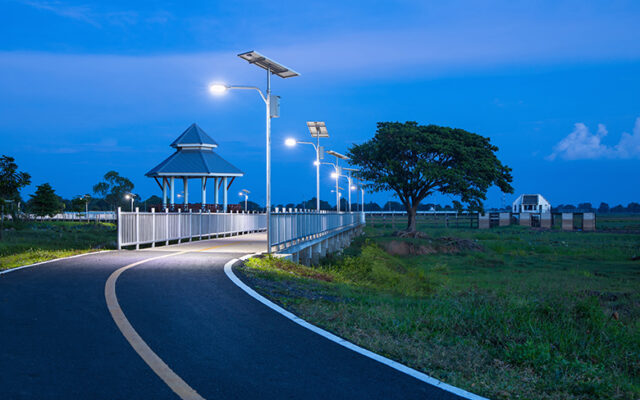
As we witness the twilight of the old era of sodium and mercury street lamps, a new dawn breaks with the rise of LED street lights, transforming our public spaces and infrastructure with stunning brilliance. This emerging epoch, aptly named the “Era of Illumination,” brings not only increased luminosity but a cornucopia of other benefits, signaling an impressive evolution in how we perceive and use light in public spaces. From energy efficiency and environmental preservation to cost savings and improved safety, the advantages illuminate a brighter path forward.
Environmental Advantages
A significant triumph of LED solar street lights is the substantial reduction in environmental impact compared to traditional lighting sources. These devices release fewer greenhouse gases, contribute less to global warming, and are constructed without hazardous materials like mercury, which conventional bulbs contain. Thus, when an LED light retires, it presents less of an environmental disposal problem, marking a substantial advancement in sustainable urban infrastructure.
They produce light in a highly targeted manner, reducing unnecessary light pollution that often disturbs wildlife habitats and human sleeping patterns. Their directional lighting ability means they emit light where it is required rather than in all directions. This precise illumination not only conserves energy but also safeguards night skies, contributing to a cleaner, greener environment.

Energy Efficiency Benefits
LEDs, or Light Emitting Diodes, are champions of energy efficiency. They utilize a remarkable 80-90% of their energy consumption for actual light production, starkly contrasting traditional lighting systems that dissipate most energy as heat. This dramatic reduction in wasted energy leads to decreased greenhouse gas emissions, further bolstering the environmental friendliness of LEDs.
Light-emitting diodes also shine longer. They operate effectively even under extreme temperatures, outperforming other lighting systems in frigid conditions without compromising their efficiency. This flexibility and resilience in various weather conditions make LED street lights a sound investment for any city, irrespective of the climate.
Cost Savings with Solar Street Lights
Merging LED street lights with solar power technology yields an extraordinary synergy, leading to even more substantial savings. Solar LED street lights are self-sufficient, harvesting the sun’s energy during the day, and stored in a battery for use after sunset. This use of renewable energy sources translates into significant cost reductions, as the need for expensive wiring and electricity costs are eliminated.
Simultaneously, these solar-powered LED street lights are more resilient to power outages. With traditional systems, a grid failure plunges entire neighborhoods into darkness. However, since solar LEDs operate independently, they continue to illuminate, enhancing safety and security during power outages, further reinforcing their cost-effectiveness and reliability.

Independence from the Grid
Street lights that operate independently of the power grid provide more than cost savings. They also offer unparalleled versatility. With no requirement for trenching and cabling, these standalone devices can be installed in remote areas, such as rural communities, hiking trails, or disaster-prone regions, making light accessible where it is most needed.
Beyond accessibility, there’s a compelling advantage of resilience. Natural disasters, grid failures, or maintenance issues that might plunge conventional systems into darkness pose minimal threats to off-grid LED systems. This independence ensures consistent lighting provision, adding to the security and comfort of the communities they serve.
Improved Safety and Security
LED street lights’ improved luminosity and color rendering make for clearer, brighter streets, enhancing visibility for motorists and pedestrians alike. This improved visibility significantly reduces the risk of accidents, contributing to safer urban and rural environments. The enhanced light quality also enables better facial recognition and color differentiation, a critical feature for security cameras and thus, crime prevention.
The LED’s ability to reach full brightness instantly, unlike traditional lights which take time to warm up, ensures immediate illumination when connected to motion sensors. This feature provides an added layer of security, dissuading potential intruders or vandals, and ensuring well-lit spaces even in the most remote or less frequented areas.
Versatility and Adaptability
The adaptability of LED street lights is another defining strength. They can be dimmed or brightened as needed, offering an efficient solution for dynamic urban landscapes. Areas with low traffic during the night can be dimmed to conserve energy while still maintaining sufficient light for safety and security.
In a similar vein, LED lights are remarkably versatile in terms of color temperature. They can emit a warmer or cooler light, accommodating the desired ambiance for various environments. For instance, a warmer hue might be chosen for a park to create a comforting atmosphere, while a cooler, brighter light may be preferred for high-traffic urban areas.

Minimal Maintenance and Long Lifespan
LEDs boast a prodigious lifespan, up to 100,000 hours of operation or more, dwarfing traditional street light longevity. This impressive durability translates into lower maintenance and replacement costs, further enhancing their cost-effectiveness. Additionally, their robust nature means fewer service disruptions, ensuring reliable light availability.
This long lifespan is complemented by the robustness of LED lights. They are more resistant to shocks, vibrations, and impacts, making them less prone to damage during installation or due to external factors such as adverse weather conditions. This attribute reinforces their suitability for a wide range of environments and applications, including those with harsh conditions.
Integration of Smart Technology
The LED revolution coincides with the rise of smart technologies, resulting in a symbiotic relationship that elevates their potential. LED street lights can be seamlessly integrated into smart city infrastructure, monitored, and controlled remotely to optimize light levels, detect outages, and gather useful data about energy usage and performance.
Beyond this, LED street lights offer an impressive platform for additional smart city technologies. They can host Wi-Fi routers, electric vehicle charging stations, or sensors to monitor air quality, traffic, or weather. By merging illumination with information, LED street lights are poised to become a key pillar in the smart city architectures of the future.

Summary
In the new era of illumination, LED street lights shine as beacons of progress. They bring a myriad of benefits – environmental sustainability, energy efficiency, cost savings, improved safety, and adaptability, to name a few. As they merge with smart technologies, these humble light fixtures are set to play an integral role in shaping the cities of tomorrow. As we navigate the path forward, let’s bask in the brilliance of LED street lights, recognizing their transformative potential in creating a more sustainable, safe, and connected world.









